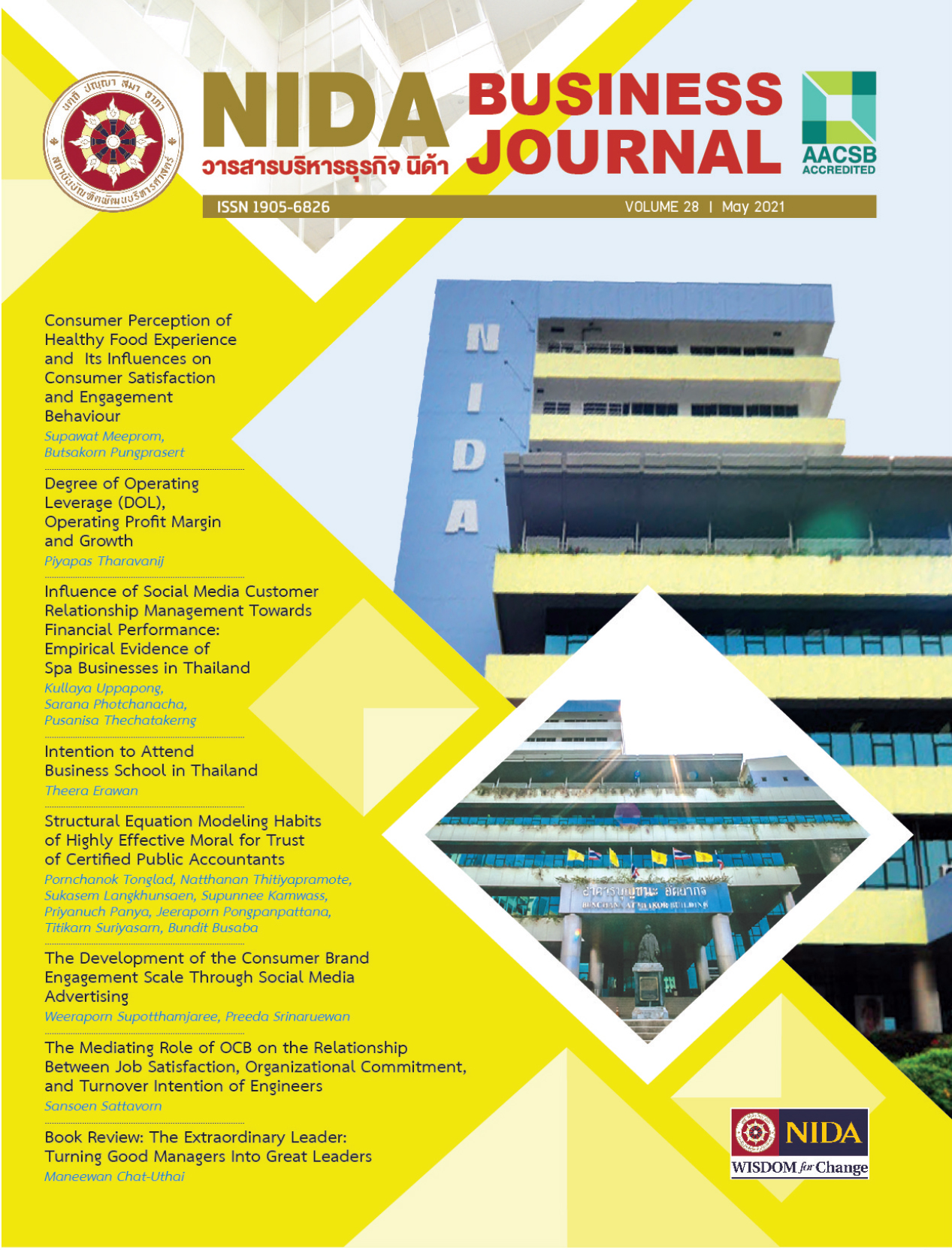การพัฒนามาตรวัดการมีส่วนร่วมกับตราสินค้าของผู้บริโภค ผ่านการโฆษณาทางสื่อสังคมออนไลน์
คำสำคัญ:
มาตรวัดการมีส่วนร่วมกับตราสินค้าของผู้บริโภค, การโฆษณาทางสื่อสังคมออนไลน์, การรับรู้, อารมณ์, พฤติกรรมบทคัดย่อ
แนวคิดการมีส่วนร่วมกับตราสินค้าของผู้บริโภค (Consumer Brand Engagement: CBE) เป็นประเด็นที่กำลัง ได้รับความสนใจจากนักวิชาการด้านการตลาด ด้วยเป็นตัวชี้วัดประสิทธิภาพของตราสินค้าจากการโฆษณาผ่านสื่อสังคม ออนไลน์ อย่างไรก็ตาม งานวิจัยในอดีตยังมีการใช้แนวคิด นิยามศัพท์ และมิติที่ใช้ในการวัดที่แตกต่างกัน การศึกษานี้ได้นำงานวิจัยของ Hollebeek, Glynn และ Brodie (2014) มาเป็นแนวทางในการพัฒนามาตรวัดการมีส่วนร่วมกับตราสินค้า ของผู้บริโภค และได้ต่อยอดองค์ความรู้เดิมในส่วนของการวิเคราะห์ปัจจัยเชิงยืนยัน (Confirmatory Factor Analysis: CFA) โดยได้ทำการวิเคราะห์ CBE เป็นปัจจัยเชิงยืนยันลำดับที่สอง (Second-Order) ต่อจากปัจจัยลำดับที่หนึ่ง (First-Order) ซึ่งประกอบด้วย การรับรู้ (Cognitive) อารมณ์ (Emotional) และพฤติกรรม (Behavioral)
ผลการวิเคราะห์ปัจจัยเชิงยืนยันลำดับที่สองจากหน่วยตัวอย่างจำนวน 560 คน สามารถยืนยันได้ว่าปัจจัยการมี ส่วนร่วมกับตราสินค้าของผู้บริโภคมีโครงสร้างที่ประกอบด้วย 3 มิติ คือ การรับรู้ อารมณ์ และพฤติกรรม ทั้งนี้ ผลการ วิเคราะห์มีความตรงเชิงลู่เข้า ความตรงเชิงจำแนก และความเที่ยงตรงเชิงโครงสร้างในระดับสูง
การศึกษานี้จึงเป็นการต่อยอดองค์ความรู้เดิม คือ การวิเคราะห์ปัจจัยการมีส่วนร่วมกับตราสินค้าของผู้บริโภคเป็น ปัจจัยเชิงยืนยันลำดับที่สองที่สะท้อนถึงองค์ประกอบ 3 มิติ คือ การรับรู้ อารมณ์ และพฤติกรรม นอกจากนี้ ผู้ประกอบการ สามารถประยุกต์ผลที่ได้เพื่อใช้เป็นมาตรวัดการมีส่วนร่วมกับตราสินค้าของผู้บริโภคผ่านการโฆษณาทางสื่อสังคมออนไลน
References
Algesheimer, R., Dholakia, U. M., & Herrmann, A. (2005). The social influence of brand community: Evidence from European car clubs. Journal of Marketing, 69(3), 19-34.
Algharabat, R., Rana, N. P., Dwivedi, Y. K., Alalwan, A. A., & Qasem, Z. (2018). The effect of telepresence, social presence and involvement on consumer brand engagement: An empirical study of nonprofit organizations. Journal of Retailing and Consumer Services, 40, 139-149.
Amornwiwat, S., Rattanaphinyoawong, T., Homchampa, T., Mintakhin, N., Phaophongphaiboon, S., & Arakwichanan, N. (2014). Strategies for binding the minds of consumers GenY. EIC Online. Retrieved from https://www.scbeic.com/th/detail/file/product/130/dzi68owq5l/8372_20141112161337.pdf
Bowden, J. L.-H. (2009). The Process of Customer Engagement: A Conceptual Framework. The Journal of Marketing Theory and Practice, 17(1), 63-74. https://doi.org/10.2753/MTP1069-6679170105
Brislin, R. W. (1980). Translation and content analysis of oral and written materials. Methodology, 389-444.
Brodie, R. J., Hollebeek, L. D., Jurić, B., & Ilić, A. (2011). Customer Engagement: Conceptual Domain, Fundamental Propositions, and Implications for Research. Journal of Service Research, 14(3), 252-271. https://doi.org/10.1177/1094670511411703
Brodie, R. J., Ilic, A., Juric, B., & Hollebeek, L. (2013). Consumer engagement in a virtual brand community: An exploratory analysis. Journal of Business Research, 66(1), 105-114. https://doi.org/10.1016/ j.jbusres.2011.07.029
Bryson, C., & Hand, L. (2007). The role of engagement in inspiring teaching and learning. Innovations in Education and Teaching International, 44(4), 349-362.
Calder, B. J., Malthouse, E. C., & Schaedel, U. (2009). An Experimental Study of the Relationship between Online Engagement and Advertising Effectiveness. Journal of Interactive Marketing, 23(4), 321-331. https://doi.org/10.1016/j.intmar.2009.07.002
Chitarayakul, K., Srithai, C., Nuntaworapun, Y., Ruenpirom, W., Mahakhant, S., & Opasanon, S. (2019). Development of Logistics Risk Indicators. NIDA Business Journal, 24(5), 42-67.
Comrey, A. L., & Lee, H. B. (1992). A First Course in Factor Analysis, 2nd Edn. Hillsdale, NJ: L.
Dessart, L., Veloutsou, C., & Morgan-Thomas, A. (2016). Capturing consumer engagement: Duality, dimensionality and measurement. Journal of Marketing Management, 32(5-6), 399-426.
Digital Advertising Association & Kantar. (2019). Thailand digital advertising spend 2018-2019. Retrieved from https://static-daat-prod.s3.amazonaws.com/Digital-Ad-Spend-press-report-2019-v2.pdf
Dwivedi, A. (2015). A higher-order model of consumer brand engagement and its impact on loyalty intentions. Journal of Retailing and Consumer Services, 24, 100-109.
Fernandes, T., & Esteves, F. (2016). Customer engagement and loyalty: A comparative study between service contexts. Services Marketing Quarterly, 37(2), 125-139.
Frank, F. D., Finnegan, R. P., & Taylor, C. R. (2004). The race for talent: Retaining and engaging workers in the 21st century. Human Resource Planning, 27(3).
Gambetti, R. C., & Graffigna, G. (2010). The Concept of Engagement: A Systematic Analysis of the Ongoing Marketing Debate. International Journal of Market Research, 52(6), 801-826. https://doi.org/ 10.2501/S147078531020166
Hair, J., Black, W. C., Babin, B. J., & Anderson, R. E. (2010). Multivariate data analysis: International version. New Jersey, Pearson.
Harrigan, P., Evers, U., Miles, M., & Daly, T. (2017). Customer engagement with tourism social media brands. Tourism Management, 59, 597-609.
Heath, R. (2007). How do we predict advertising attention and engagement. School of Management University of Bath Working Paper, 9
Heath, R. (2009). Emotional engagement: How television builds big brands at low attention. Journal of Advertising Research, 49(1), 62-73.
Hepola, J., Karjaluoto, H., & Hintikka, A. (2017). The effect of sensory brand experience and involvement on brand equity directly and indirectly through consumer brand engagement. Journal of Product & Brand Management, 26(3), 282-293.
Higgins, E. T., & Scholer, A. A. (2009). Engaging the consumer: The science and art of the value creation process. Journal of Consumer Psychology, 19(2), 100-114. https://doi.org/org/10.1016/j.jcps. 2009.02.002
Hollebeek, L. (2011a). Demystifying customer brand engagement: Exploring the loyalty nexus. Journal of Marketing Management, 27(7-8), 785-807. https://doi.org/10.1080/0267257X.2010.500132
Hollebeek, L. (2011b). Exploring customer brand engagement: Definition and themes. Journal of Strategic Marketing, 19(7), 555-573. https://doi.org/10.1080/0965254X.2011.599493
Hollebeek, L. D., Conduit, J., & Brodie, R. J. (2016). Strategic Drivers, Anticipated and Unanticipated Outcomes of Customer Engagement.
Hollebeek, L. D., Glynn, M. S., & Brodie, R. J. (2014). Consumer Brand Engagement in Social Media: Conceptualization, Scale Development and Validation. Journal of Interactive Marketing, 28(2), 149-165. https://doi.org/10.1016/j.intmar.2013.12.002
Huo, Y. J., Binning, K. R., & Molina, L. E. (2010). Testing an integrative model of respect: Implications for social engagement and well-being. Personality and Social Psychology Bulletin, 36(2), 200-212.
Ilic, A. (2008). Towards a conceptualisation of consumer engagement in online communities: A netnographic study of vibration training online community. Unpublished Master’s Thesis, University of Auckland (Department of Marketing), Auckland, New Zealand.
Islam, J. U., & Rahman, Z. (2016). Examining the effects of brand love and brand image on customer engagement: An empirical study of fashion apparel brands. Journal of Global Fashion Marketing, 7(1), 45-59.
Jarvis, C. B., MacKenzie, S. B., & Podsakoff, P. M. (2003). A critical review of construct indicators and measurement model misspecification in marketing and consumer research. Journal of Consumer Research, 30(2), 199-218.
Jennings, M. K., & Stoker, L. (2004). Social trust and civic engagement across time and generations. Acta Politica, 39(4), 342-379.
Kahn, W. A. (1990). Psychological conditions of personal engagement and disengagement at work. Academy of Management Journal, 33(4), 692-724.
Kilger, M., & Romer, E. (2007). Do measures of media engagement correlate with product purchase likelihood? Journal of Advertising Research, 47(3), 313-325.
Kim, J.-O., & Mueller, C. W. (1978). Factor analysis: Statistical methods and practical issues. sage.
Kline, R. B. (2004). Principles and practice of structural equation modeling (Vol. 2).
Kumar, V. (2015). Evolution of marketing as a discipline: What has happened and what to look out for. Journal of Marketing, 79(1), 1-9.
Kumar, V., AKsoy, L., Donkers, B., Venkatesan, R., Wiesel, T., & Tillmanns, S. (2010). Undervalued or overvalued customers: Capturing total customer engagement value. Journal of Service Research, 13(3), 297-310. https://doi.org/10.1177/1094670510375602
Leckie, C., Nyadzayo, M. W., & Johnson, L. W. (2016). Antecedents of consumer brand engagement and brand loyalty. Journal of Marketing Management, 32(5-6), 558-578.
London, B., Downey, G., & Mace, S. (2007). Psychological theories of educational engagement: A multimethod approach to studying individual engagement and institutional change. Vand. L. Rev., 60, 455.
Lynn, M. R. (1986). Determination and quantification of content validity. Nursing Research.
May, D. R., Gilson, R. L., & Harter, L. M. (2004). The psychological conditions of meaningfulness, safety and availability and the engagement of the human spirit at work. Journal of Occupational and Organizational Psychology, 77(1), 11-37.
Mollen, A., & Wilson, H. (2010). Engagement, telepresence and interactivity in online consumer experience: Reconciling scholastic and managerial perspectives. Journal of Business Research, 63(9-10), 919-925. https://doi.org/10.1016/j.jbusres.2009.05.014
MSI-Marketing Science Institute. (2010). 2010-2012 Research Priorities. Retrieved from http://image.sciencenet.cn/olddata/kexue.com.cn/upload/blog/file/2010/9/201091515178616316.pdf
MSI-Marketing Science Institute. (2014). 2014-2016 Research Priorities. Retrieved from http://www.msi.clients.bostonwebdevelopment.com/research/msi-research-priorities/
Neff, J. (2007). OMD proves the power of engagement. Advertising Age, 78(27), 3-4.
Oxford, O. E. (2009). Oxford English Dictionary. Oxford: Oxford University Press.
Pansari, A., & Kumar, V. (2017). Customer engagement: The construct, antecedents, and consequences. Journal of the Academy of Marketing Science, 45(3), 294-311.
Pattarasinsoontorn, P., & Wattanakamolchai, S. (2014). The Effects of the perception of Utility and Servicecape on Customer Loyalty for Premium Coffee Shops in Bangkok. (Thesis) Bangkok University, 36.
Patterson, P., Yu, T., & De Ruyter, K. (2006). Understanding customer engagement in services. Australia– New Zealand Marketing Academy Conference, Brisbane. Retrieved May 7, 2010. Retrieved from http://smib.vuw.ac.nz:8081/WWW/ANZMAC2006/documents/Pattinson_Paul.pdf
Pham, M. T., & Avnet, T. (2009). Rethinking Regulatory Engagement Theory. Journal of Consumer Psychology, 19(2), 115-123. https://doi.org/10.1016/j.jcps.2009.02.003
Phillips, B. J., & McQuarrie, E. F. (2010). Narrative and persuasion in fashion advertising. Journal of Consumer Research, 37(3), 368-392.
Polit, D. F., & Beck, C. T. (2006). The content validity index: Are you sure you know what’s being reported? Critique and recommendations. Research in Nursing & Health, 29(5), 489-497.
Salanova, M., Agut, S., & Peiró, J. M. (2005). Linking organizational resources and work engagement to employee performance and customer loyalty: The mediation of service climate. Journal of Applied Psychology, 90(6), 1217.
Schaufeli, W. B., & Bakker, A. B. (2004). Job demands, job resources, and their relationship with burnout and engagement: A multi_sample study. Journal of Organizational Behavior: The International Journal of Industrial, Occupational and Organizational Psychology and Behavior, 25(3), 293-315.
Schaufeli, W. B., Salanova, M., González-Romá, V., & Bakker, A. B. (2002). The measurement of engagement and burnout: A two sample confirmatory factor analytic approach. Journal of Happiness Studies, 3(1), 71-92.
Schau, H. J., & Muniz Jr, A. M. (2004). If you can’t find it, create it: An analysis of consumer engagement with Xena: Warrior Princess. Advances in Consumer Research, 31, 554-557.
Schau, H. J., Muñiz Jr, A. M., & Arnould, E. J. (2009). How brand community practices create value. Journal of Marketing, 73(5), 30-51.
Shut, W. (2018). Bangkok also Champ Facebook in 2018. Retrieved from https://ahead.asia/2018/04/23/%E0%B8%B4bangkok-most-fb-user-city-2018/
Sinthuwatin, W. (2015a). Thailand’s Most Admired Brand & Why We Buy. Brandage, 16(1), 240-241.
Sinthuwatin, W. (2015b). Thailand’s Most Social Power Brand. Brandage, 16(6), 165-166.
Sprott, D., Czellar, S., & Spangenberg, E. (2009). The importance of a general measure of brand engagement on market behavior: Development and validation of a scale. Journal of Marketing Research, 46(1), 92-104.
Statista Digital Market Outlook. (2016). Digital Advertising: Social Media. Retrieved from http://www.199it .com/wp-content/uploads/2016/08/2016-8-12Social_Media_Advertising_Outlook_0716.pdf
Tabachnick, B. G., Fidell, L. S., & Ullman, J. B. (2007). Using Multivariate Statistics (Vol. 5). Pearson Boston, MA.
Thakur, R. (2016). Understanding customer engagement and loyalty: A case of mobile devices for shopping. Journal of Retailing and Consumer Services, 32, 151-163.
Van Doorn, J., Lemon, K. N., Mittal, V., Nass, S., Pick, D., Pirner, P., & Verhoef, P. C. (2010). Customer Engagement Behavior: Theoretical Foundations and Research Directions. Journal of Service Research, 13(3), 253-266. https://doi.org/10.1177/1094670510375599
Vanichbuncha, K. (2014). Analysis of Structural Equation Model (SEM) with AMOS (2nd ed.). Bangkok: Sam Lada Limited Partnership.
Vivek, S. D., Beatty, S. E., & Morgan, R. M. (2012). Customer Engagement: Exploring Customer Relationships Beyond Purchase. The Journal of Marketing Theory and Practice, 20(2), 122-146. https://doi.org/10.2753/MTP1069-6679200201
Wang, A. (2006). Advertising engagement: A driver of message involvement on message effects. Journal of Advertising Research, 46(4), 355-368.
Zhang, K. Z. K., & Benyoucef, M. (2016). Consumer behavior in social commerce: A literature review. Decision Support Systems, 86, 95-108. https://doi.org/10.1016/j.dss.2016.04.001
Downloads
เผยแพร่แล้ว
How to Cite
ฉบับ
บท
License

This work is licensed under a Creative Commons Attribution-NonCommercial-NoDerivatives 4.0 International License.



